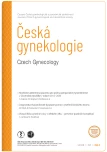Nascent myoma as a cause of urinary retention
Authors:
M. Tomanová; I. Semerádová; I. Lukáčová
Authors‘ workplace:
Gynekologicko-porodnické oddělení, Nemocnice AGEL Ostrava-Vítkovice a. s.
Published in:
Ceska Gynekol 2023; 88(5): 372-375
Category:
Case Report
doi:
https://doi.org/10.48095/cccg2023372
Overview
We present the case of a 47-year-old woman with a bulky, nascent necrotic myoma, which at first glance appeared to be a malignant process in the cervix. It caused significant retention of urine due to compression of the bladder and ureters, hydronephrosis and deterioration of renal function. A fully developed picture of the “bulge syndrome” dominated – lymphedema of the lower limbs and lower abdomen, pain in the lower abdomen, constipation, secondary secondary urinary infection, and paradoxical ischuria. During a gynecological examination in a specula, a strong-smelling, necrotic tumour was visualized reaching half of the vagina, which was causing a bloody discharge, which brought the patient to the examination. A biopsy was taken from the tumour. A permanent urinary catheter was inserted into the urinary bladder with gradual adjustment of renal functions. Due to the difficulties and the benign histological findings from the biopsy, a simple abdominal hysterectomy with bilateral salpingectomy from a lower midline incision was indicated. The operation was complicated by an extensive adhesive process and blood loss of 1,200 mL, with a decrease in hemoglobin in the blood count from 128 g/L to 79 g/L and the need for three blood transfusions. In the postoperative period, there is a prompt recovery of spontaneous micturition with normalization of bladder function, subsidence of lymphedema and subjective complaints of the patient.
Keywords:
Hysterectomy – urinary retention – myoma – bulky diseases – nascent uterine myoma
Sources
1. Bajekal N, Li TC. Fibroids, infertility and pregnancy wastage. Hum Reprod Update 2000; 6 (6): 614–620. doi: 10.1093/humupd/6.6.614.
2. Mára M, Holub Z. Děložní myomy: moderní diagnostika a léčba. Praha: Grada 2009.
3. Veselý K. Prognostická imunohistochemie u sarkomů měkkých tkání. Dizertační práce. Brno 2008: 12–64. Více na: www.muni.cz.
4. Al-Shukri M, Al-Ghafri W, Al-Dhuhli H et al. Vaginal myomectomy for prolapsed submucous fibroid: it is not only about size. Oman Med J 2019; 34 (6): 556–559. doi: 10.5001/omj.2019.100.
5. Golan A, Zachalka N, Lurie S et al. Vaginal removal of prolapsed pedunculated submucous myoma: a short, simple, and definitive procedure with minimal morbidity. Arch Gynecol Obstet 2005; 271 (1): 11–13. doi: 10.1007/s00 404-003-0590-x.
6. Aydın S, Göksever Çelik H, Maraşlı M et al. Clinical predictors of successful vaginal myomectomy for prolapsed pedunculated uterine leiomyoma. J Turk Ger Gynecol Assoc 2018; 19 (3): 146–150. doi: 10.4274/jtgga.2017.0135.
7. Ferrari F, Forte S, Valenti G et al. Current treatment options for cervical leiomyomas: a systematic review of literature. Medicina (Kaunas) 2021; 57 (2): 92. doi: 10.3390/medicina57020092.
8. Hwang KS, Ding DC. Female acute urinary retention caused by anterior deflection of the cervix which was augmented by a uterine myoma. Taiwan J Obstet Gynecol 2008; 47 (3): 350-351. doi: 10.1016/S1028-4559 (08) 60141-2.
Labels
Paediatric gynaecology Gynaecology and obstetrics Reproduction medicineArticle was published in
Czech Gynaecology

2023 Issue 5
Most read in this issue
- Early treatment of vulvar synechiae in childhood – prevention of late complications
- Relugolix combination therapy and symptoms of uterine myomatosis – selected case reports of indication spectrum and treatment outcomes
- Implementation of the ERAS protocol in gynecology and oncogynecology – evaluation of a pilot study
- Nascent myoma as a cause of urinary retention
